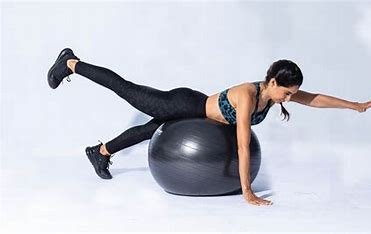
🧠 Using Stability Balls for Balance Training: A Complete Guide
Introduction
In recent years, the fitness industry has seen a significant shift toward functional and core-based training. Rather than isolating muscles with machines, people are now more focused on developing strength, balance, and stability that translate into everyday life. Among the most effective tools for this purpose is the stability ball—also called an exercise ball, Swiss ball, or physioball.
Originally used in physical therapy during the 1960s in Switzerland, these large inflatable balls have evolved into a mainstream fitness accessory. Stability balls are especially useful for balance training, as they create an unstable surface that challenges your body in ways traditional floor exercises cannot. But how exactly do they work? Why are they so effective? Let’s dive into the details.
What Is Balance Training and Why Is It Important?
Balance training involves exercises that improve your ability to control your body’s position, whether you’re stationary or moving. It’s not just for athletes or the elderly—it’s essential for everyone, because balance is part of every movement we make, from walking to reaching for something on a shelf.
Poor balance can lead to:
- Increased risk of falls
- Muscle imbalances
- Joint instability
- Poor posture and back pain
Improving balance enhances your coordination, strengthens stabilizing muscles, and boosts athletic performance.
Why Use a Stability Ball?
The key principle behind a stability ball is instability. When you sit, lie, or exercise on the ball, your body must constantly adjust to keep balanced. This engages your core stabilizers, including:
- Rectus abdominis (front abs)
- Transverse abdominis (deep core muscle)
- Obliques (side abs)
- Erector spinae (lower back muscles)
- Hip flexors and glutes
These muscles work together to stabilize the spine and pelvis—improving not only your core strength but also your posture, coordination, and overall movement efficiency.
Benefits of Stability Ball Balance Training
✅ 1. Builds Core Strength
Since the core muscles have to constantly fire to keep you steady, they become stronger and more resilient.
✅ 2. Enhances Posture and Spinal Alignment
Using the ball encourages proper spinal alignment, which improves posture over time. Sitting on the ball instead of a chair, for example, can train you to sit up straight.
✅ 3. Improves Muscle Coordination
Multiple muscle groups work together during ball exercises, promoting better coordination and neuromuscular control.
✅ 4. Increases Balance and Proprioception
Training on an unstable surface develops your sense of where your body is in space (proprioception), which is crucial for injury prevention and athletic performance.
✅ 5. Supports Joint Stability and Mobility
Stability balls can be used to safely strengthen joints and increase the range of motion in controlled environments.
✅ 6. Versatile and Accessible
They’re inexpensive, portable, and can be used at home, in the gym, or even at the office.
Scientific Basis
According to studies published in the Journal of Strength and Conditioning Research and Journal of Physical Therapy Science, exercising on unstable surfaces like stability balls increases core muscle activation significantly compared to stable surfaces.
One study found that doing crunches on a stability ball activated the abdominal muscles more than twice as much as doing them on the floor.
Another found that incorporating stability ball training in rehabilitation helped improve balance and mobility in patients recovering from injury.
Example Exercises Using Stability Balls
Here are a few great balance-focused exercises using the ball:
- Ball Sit Balance
- Sit on the ball with feet flat on the floor, knees at 90 degrees.
- Lift one foot slightly and hold for 10–30 seconds. Switch.
- Works on core control and balance.
- Stability Ball Plank
- Place forearms on the ball and feet on the floor.
- Hold a plank position while keeping the ball steady.
- This variation increases core activation and shoulder stability.
- Wall Squats with Stability Ball
- Place the ball between your lower back and a wall.
- Lower into a squat while keeping the ball rolling behind you.
- Adds support while requiring balance and coordination.
- Hamstring Curls
- Lie on your back, heels on top of the ball.
- Lift hips and roll the ball toward your glutes using your heels.
- Engages the glutes, hamstrings, and core.
- Bird Dog on Stability Ball
- Lie face-down with your belly on the ball, hands and feet on the ground.
- Lift opposite arm and leg and hold for balance.
- Improves core, back, and limb coordination.
Tips for Effective and Safe Use
- Choose the right size ball based on your height (e.g., 55cm for people 5’0″–5’5″, 65cm for 5’6″–6’0″).
- Inflate the ball properly so it’s firm but slightly springy.
- Start with support (e.g., near a wall) until you’re comfortable.
- Focus on form, not speed. Move slowly and with control.
- Avoid using the ball on slippery surfaces to reduce fall risk.
Conclusion
Stability balls are a simple yet powerful tool for improving balance, core strength, posture, and overall movement efficiency. By creating a slightly unstable environment, they force your body to engage muscles that might otherwise go underused in traditional workouts. Whether you’re an athlete looking to improve performance, someone recovering from an injury, or just hoping to feel more stable and aligned in daily life, adding balance training with a stability ball can be a game-changer.
It’s not just about getting stronger—it’s about moving better, feeling more in control of your body, and reducing the risk of injury. So next time you’re planning your workout, consider swapping the bench or mat for a stability ball—and challenge your body in a new, more dynamic way.
